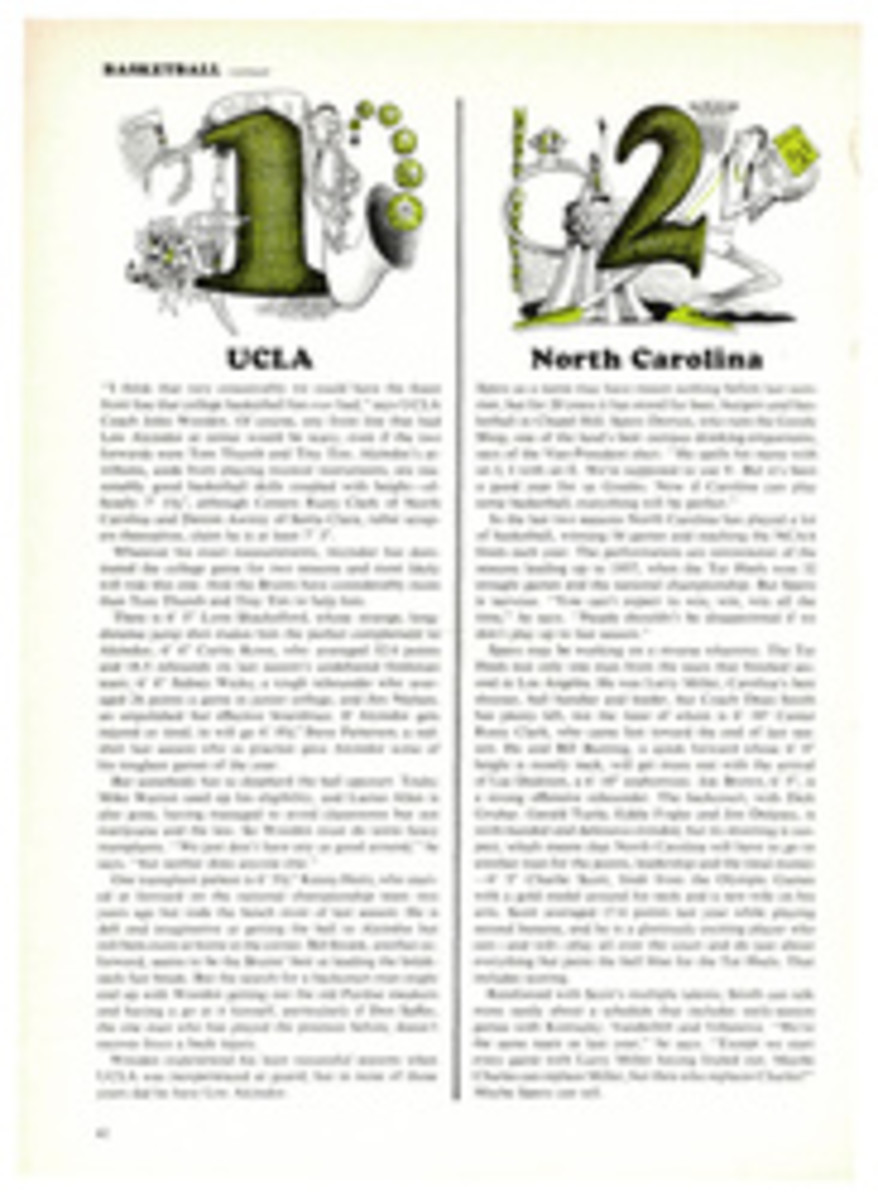
Longer lives from a mass death
In a most unlikely place—the trackless land of British Columbia, where bald eagles still wheel over evergreen ridges that shelter moose, mountain sheep and bear—today's medical scientists are fishing in some of the world's finest salmon waters for a fountain of youth. What they are seeking, specifically, are clues to aging in the Pacific salmon, a fish programmed by nature to die within weeks of leaving the ocean to spawn in the river of its birth. In those short weeks the salmon ages as much as a man does in 20 to 40 years.
Intrigued by the phenomenon of these salmon, the Scripps Institution of Oceanography in La Jolla, Calif. invited 37 specialists, 12 of them medical doctors and 25 of them biological scientists, to go fishing for facts on the Bella Coola and Dean rivers in British Columbia. The group included blood, brain, bone and heart experts, specialists in tropical and children's diseases, a milk biochemist from Penn State's Department of Dairy Sciences and an authority on liver enzymes from the Hadassah School of Medicine in Jerusalem. As they headed south from Juneau, Alaska last August on Scripps' 133-foot, 300-ton floating laboratory, the Alpha Helix, Professor Gerard Milhaud of the University of Paris admitted he had never touched a live fish (and it took him a couple of weeks on the Bella Coola before he would pick up a squirming salmon).
The fishing equipment on board was as unsophisticated as Huck Finn's, but the scientific gear was something else. The Alpha Helix carried a $35,000 electron microscope that magnified objects up to 40,000 times their size, an $8,000 centrifuge that separated various elements in blood samples and diamond knives that could slice tissue specimens as thin as one-millionth of an inch. The $1.4 million ship was built three years ago so that biochemists and medical men could study various scientific problems on the spot, make conclusions on an experiment and then quickly proceed to the next question.
For the Scripps' salmon fishing party the original goal was to determine if coho, sockeye and pink salmon contract heart disease in the stress of spawning and if this is actually what kills them. For five years Dr. Robert Van Citters, a cardiovascular physiologist at the University of Washington, who was the one avid fisherman included in the expedition, had been sectioning the hearts of fish he caught on Northwest rivers. In spawning steelhead trout he had almost always found evidence of coronary disease. However, the steelhead taken at sea, before they entered the freshwater rivers to spawn, showed few traces of coronary degeneration. Unlike the Pacific salmon, the steelhead does not die upon spawning but returns to the ocean. When these fish reentered the salt water, Dr. Van Citters discovered, they recovered from the coronary disease. An earlier study showed salmon also suffered coronary trouble—similar to that found in people affected by hardening of the arteries. The scientists hoped that from the salmon and steelhead they could learn something significant about the causes and cure of heart disease.
Soon after their arrival in the town of Bella Coola a few of the group went 40 miles north to the Dean in search of steelhead. With the approval of national and local fishery departments, they set about stringing nets across the river. In the fast current they slipped, splashed, lost their nets and almost were swept out to sea. The next day they tried fishing with light tackle. Again, no success. That ended the steelhead study.
Meanwhile, back at the ship, pulmonary specialists investigating the hearts of the spawning salmon found a lower incidence of heart trouble than they had expected. Instead, the scientists found themselves fascinated with the spectacle of death in the river. Even as salmon moved up the Bella Coola to spawn, they were rotting. Some living salmon were without tails. They spawned and within hours were dead.
"The phenomenon of death was overpowering," Dr. Eberhard Trams, a neurochemist, recalls. "If you see a lot of ants die you don't give a damn. But the larger the animal, the closer it gets to home. These were magnificent, highly organized beings suffering mass death. A whole society dies; every fish of that spawning age born in that river was dying. They become senile, and you watch the disintegration of the nervous system, muscles and bone. The fish literally seem to die of death. The fisheries and wildlife people accept this death. They consider it entirely natural. No one considered it odd."
The scientists decided to concentrate their study on the salmon's strange process of aging. In their investigation they have been trying to determine whether the death of a salmon in a particular year is caused by a factor in its genetic makeup, such as its homing device, or whether its aging and precipitous death is physically triggered when it leaves the salt water and enters the river to spawn and die.
"We have learned to delay death and aging in man to an astonishing degree," Dr. Trams says. "With different diets and antibiotics, the life span of man has increased almost 40% in the last 60 years. Perhaps we can learn something to further extend man's life by using the spawning salmon as a laboratory tool."
Analyzing the metabolic decline of the salmon at Bella Coola took many forms—the calcium in the blood of fish just coming into the river was contrasted with that in the blood offish that had spawned and were dying. Comparisons were made in the pigment in their skin and flesh, the fat in their bodies, their brains, glands, hormones, livers, muscles, cells and circulation. To do this testing, a variety of equipment was employed. The dimensions of a salmon's swim bladder were found by putting a small fish in a giant mayonnaise jar filled with water and lodging the necessary pipes and gauges for measurement in the cap of the jar. Oxygen consumption in salmon was figured by putting the fish in plastic cylinders in the river, pumping a certain amount of water into the cylinders and then measuring the oxygen in the outflowing water. The circulation of a salmon's blood was charted by using an X-ray machine or by pumping radioactive Xenon 133 into its heart and then using Geiger counters to register the amount of radioactivity that had moved out to the various organs.
On the rear deck of the Alpha Helix a rubber children's swimming pool held live coho and pink salmon. Occasionally, when a fish appeared ready to belly up, someone would shove a green garden hose down his throat, sharply increasing his oxygen supply.
Don Wilkie, the only ichthyologist among the laboratory anglers, filled the scientists' daily orders. They might want four female coho or six male sockeye taken from the river or spring salmon taken from the sea. These Wilkie bought for 78¢ a pound from the purse seiners along the British Columbia coast. The spawning fish he picked up in dip nets. "Some of the scientists did not wonder, or apparently care, where the fish came from," Wilkie says. "These men tunnel in on one problem. I've seen this at Scripps where I also provide the fish for laboratory tests. I remember one man there who for several years had been analyzing the blood of the keyhole limpet, which is a snail. One day he saw one of the limpets lying intact on a table in the lab and he asked someone what it was. Biochemists should go out and find their own specimens. They would acquire an appreciation for the animal. A lot of them think getting a spring salmon is as easy as going to Woolworth's and getting a pack of chewing gum."
In Bella Coola Wilkie would watch a scientist dump a 10-pound coho in a wash basin, slosh a bucket of sea water over him and begin a test. "Some of them forgot they were dealing with a living animal," Wilkie says. "They would forget about his needs and think the salmon in the basin or the mayonnaise jar was responding normally. I had to suggest the fish might be under stress in these circumstances." It is, another naturalist suggests, something like studying the heart of a man after holding him under water for three minutes.
From their studies the scientists say they hope to gain insight into such maladies as heart attacks, strokes, arthritis, liver disorders, bone diseases, malnutrition and certain types of cancer. But the most significant research gathered is expected to be on the process of aging. To Dr. Trams an important finding was that the brain of the spawning salmon loses control over its pituitary gland. The gland increases greatly in size and productivity as the fish enters fresh water. With the pituitary running wild, there is a metabolic speedup in which the fat in the salmon's body is burned up. "It is as though all the glands were programmed to synchronize the combustion of fat simultaneously so that the whole machine runs out of fuel," Dr. Andrew A. Benson, the head of the expedition, explains. The gland that regulates the calcium in the salmon's system dissolves and with it its bones. The activity of the pituitary gland and loss of bone calcium are familiar symptoms of aging in man.
One significant difference in the physiology of fish and human, however, is the amount of cholesterol a salmon can tolerate. In the ocean it has five to 10 times as much in its bloodstream as man. High concentrations of cholesterol in humans cause strokes and heart attacks. "If we find out how the salmon manages to survive with gigantic amounts of cholesterol," Dr. Benson says, "perhaps we can help humans survive."
Engrossed in their scientific research, the doctors worked long hours—often from 9 in the morning until 2 or 3 the following morning. On a rare occasion someone would walk along the shore gathering mushrooms for hors d'oeuvres. In the evening in the lounge of the Alpha Helix they would tell their fish tales as a stereo played Bach.
They were unusual anglers but they saw value in their naiveté. "It is naiveté in the Kantian sense of the word," Dr. Trams explained. "If you do not go on a trip like that with preconceived notions, you get a lot better ideas and can visualize new approaches."
PHOTO
A FEW WEEKS EARLIER THESE DEAD SALMON WERE SLEEK SWIMMERS OF THE SEA

